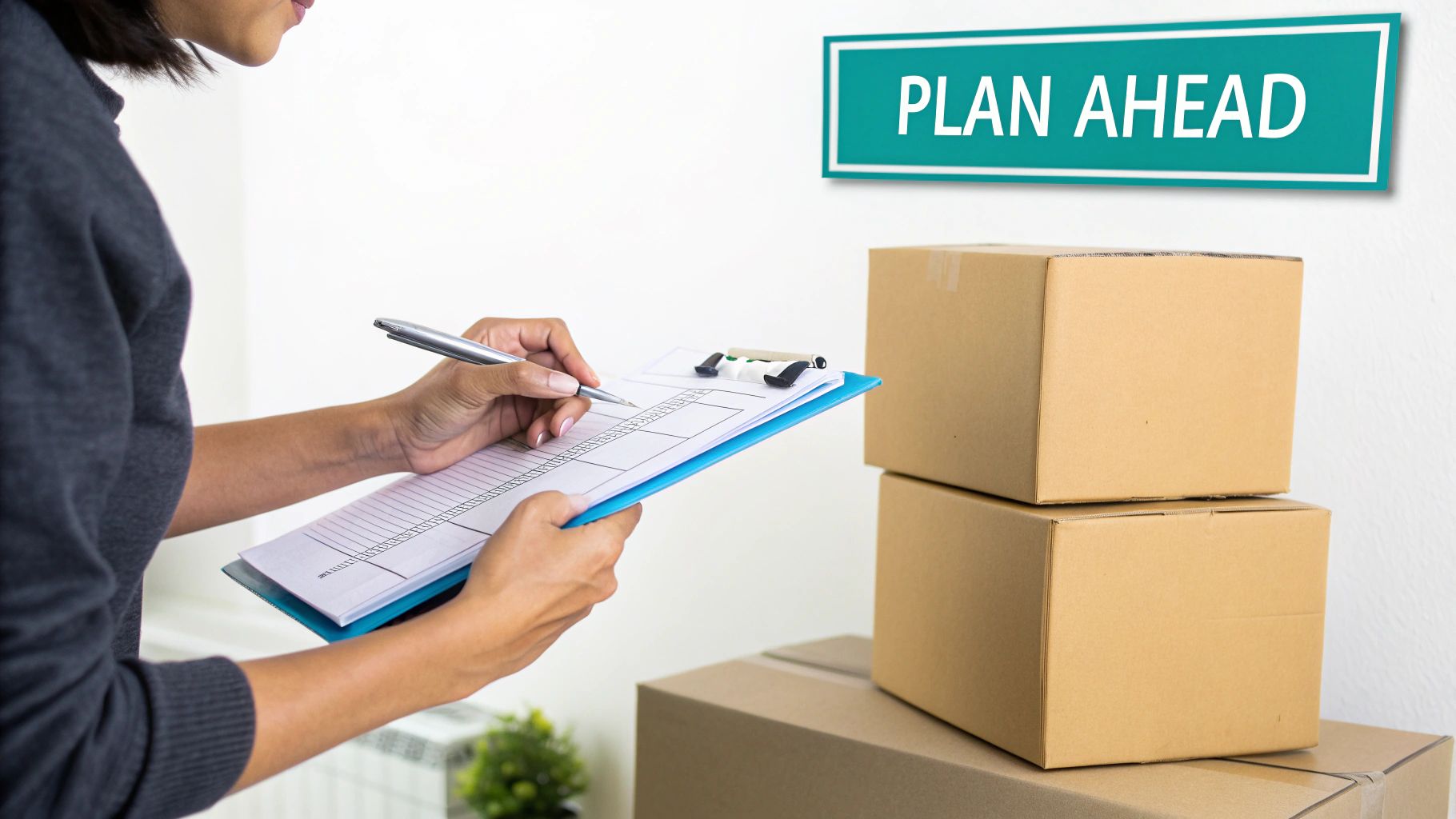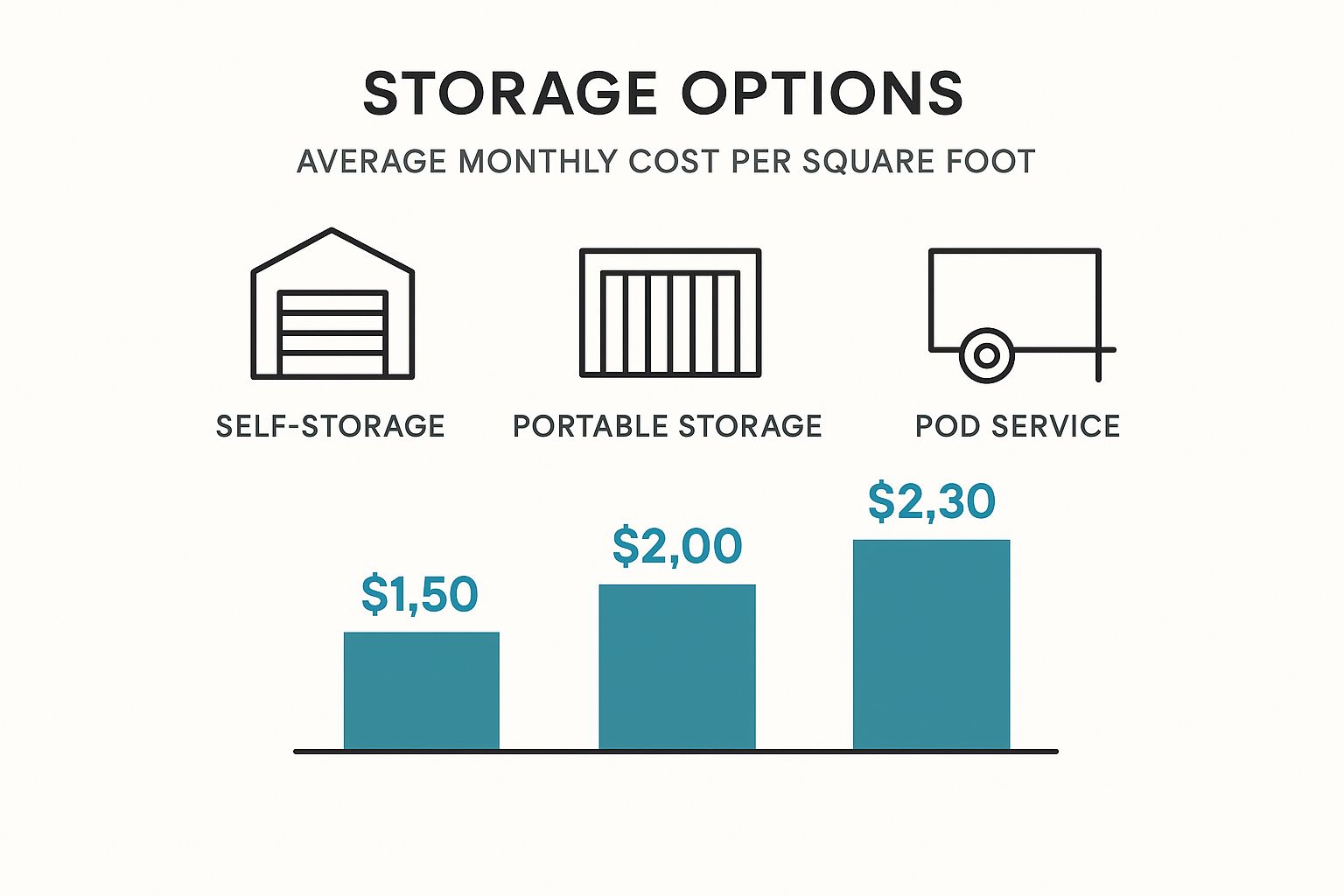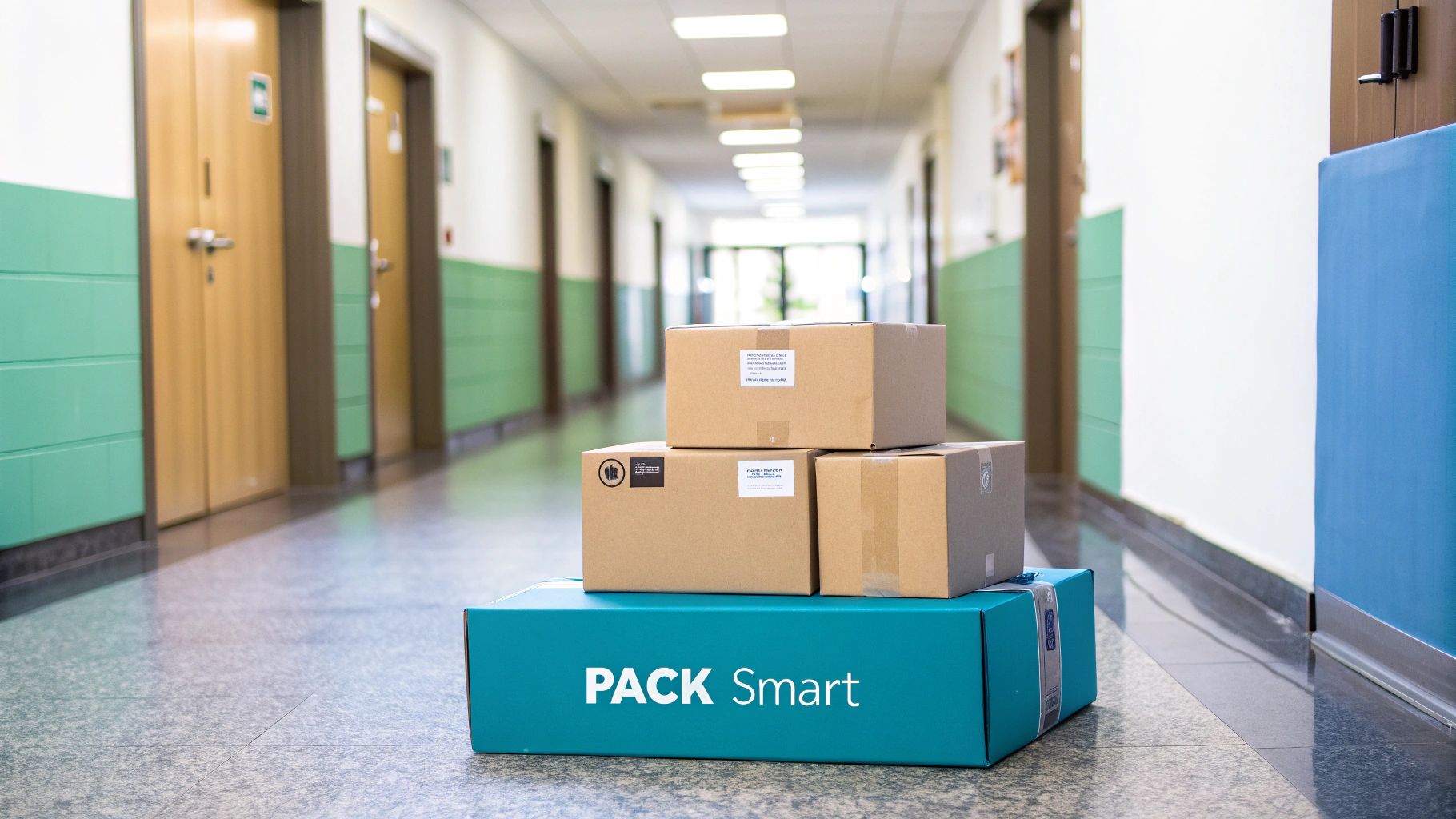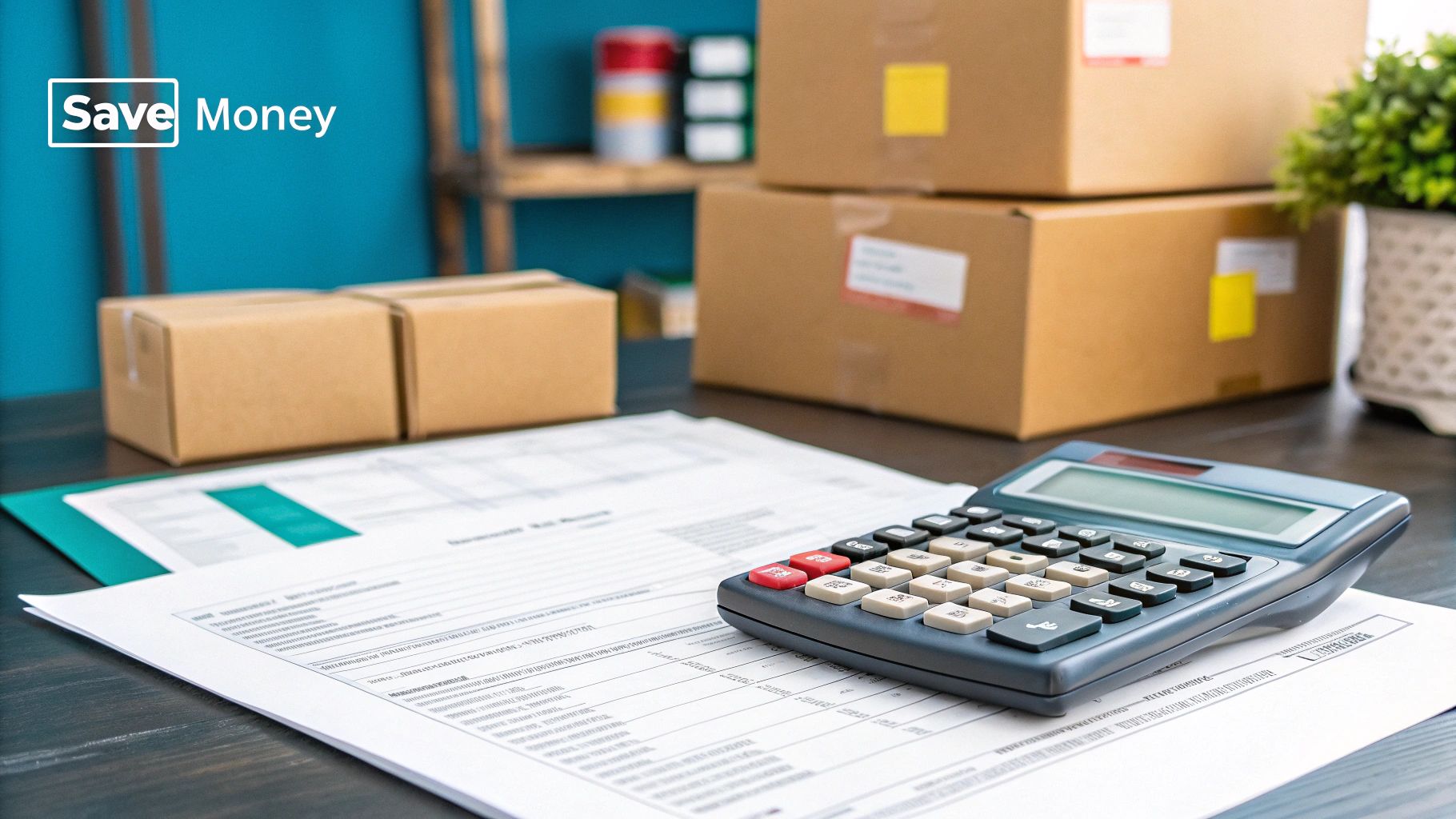Moving house is rarely the neat, one-day affair we hope for. It’s more of a marathon than a sprint, and using storage when moving house provides the crucial breathing room you need. Think of it as a temporary holding space—a way to bridge the gap between selling and buying, declutter for viewings, or just manage the chaos without being rushed off your feet.
Why Storage Is Your Secret Weapon for a Smoother Move

Let’s be honest, seamlessly moving from your old home to your new one on the exact same day is a rare beast. Property chains are notoriously complex, and completion dates can shift with little warning. This is where a storage unit transforms from a simple "nice-to-have" into an essential part of your moving plan.
By shifting non-essential items into a secure unit well ahead of time, you create a buffer zone. This flexibility means you’re ready for any last-minute curveballs without the heart-stopping panic of having all your worldly possessions in a removal lorry with nowhere to go.
Decluttering to Sell and Downsizing with Dignity
Long before your house even hits the market, a storage unit can be invaluable. Any estate agent will tell you that depersonalising and decluttering makes rooms look bigger and far more appealing to buyers. A storage unit is perfect for this.
- Stage Your Home Effectively: Temporarily move out bulky furniture, extra decor, and personal bits and pieces to really showcase your home’s best features.
- Make Downsizing Manageable: If you're moving to a smaller place, storage gives you the time to properly decide what to keep, sell, or donate. No hasty decisions you’ll regret later.
- Secure Sentimental Items: Keep treasured belongings safe from the inevitable knocks and scrapes of the moving process.
This approach doesn't just help your house sell faster; it also makes the final pack-up feel a lot less overwhelming.
Avoiding Moving Day Mayhem
The logistics of moving day can be a nightmare, especially on popular dates. For 2025, the UK is expected to see around 2.1 million house moves, with the busiest day predicted to be Friday, 29th August. On that day alone, an estimated 22,386 households will be on the move. Removal firms report that 85% experience delays on peak days simply due to the sheer volume of traffic and people. You can dig into these trends and plan your move by reviewing these insights into UK house moves.
By moving a good chunk of your belongings into storage beforehand, you seriously cut down the amount that needs handling on the day itself. This minimises stress and sidesteps the risk of costly delays.
Choosing the Right UK Storage for Your Move
Deciding you need storage when moving is often the easy part. The real challenge? Figuring out what kind of storage is right for you. The UK storage market is packed with options, and your final choice will have a direct impact on the cost, convenience, and security of your belongings while you're in limbo.
The good news is, you've got plenty of choice. The UK self-storage industry has grown massively, now valued at around £1.08 billion a year. With over 2,200 facilities offering more than 52 million square feet of space, finding a spot isn't the problem. Even so, it's interesting that the UK's storage usage per person is still just 0.8 square feet—a tiny fraction of the US average. It shows there's still plenty of room for growth in the market.
This quick snapshot shows the typical monthly costs for different storage types, helping you get a feel for your options.

As you can see, traditional self-storage often comes out as the most budget-friendly option per square foot, making it a great starting point for most people moving house.
Key Factors to Consider
Before you dive in and start collecting quotes, take a moment to think about what you actually need. A little bit of planning now will narrow down your search and make sure you end up with a facility that genuinely works for you. Don't just get fixated on the price tag; things like convenience and security are just as crucial.
Here are a few questions I always recommend people ask themselves:
- How much space do I really need? Guessing too low leads to a frantic repack on moving day, while overestimating means you're just paying to store fresh air.
- Where should it be? Closer to your old house for easy loading, or nearer the new one for simpler unloading? Think about your moving day logistics.
- What kind of access will I require? Standard 9-to-5 hours might not cut it if you need to drop things off after work or on a weekend.
- What are my security deal-breakers? For me, things like 24/7 CCTV, individual unit alarms, and a securely fenced perimeter are non-negotiable for peace of mind.
A confident decision comes from knowing what to look for and what questions to ask. A little preparation now saves a lot of potential headaches later.
Comparing Your Main Storage Options
For most house movers, it boils down to three common options: traditional self-storage, container storage, and the storage offered by removal companies. Each has its pros and cons, making them better suited for different situations.
Comparing UK Storage Options for House Movers
To help you weigh up your choices, here’s a quick comparison of the most common storage types. This should give you a clearer idea of which one might be the best fit for your moving situation.
| Storage Type | Best For | Typical Access | Security Level |
|---|---|---|---|
| Self-Storage Facility | Flexible access to belongings, storing delicate or valuable items. | Frequent, often with extended hours or 24/7 options. | High (CCTV, alarms, gated access). |
| Container Storage | Bulky, less sensitive items like garden furniture or tools. | More restricted, often by appointment or during set hours. | Varies, usually secure but less hi-tech than indoor facilities. |
| Removals Company Storage | Maximum convenience where the company handles everything. | Limited, usually requires booking an appointment to access. | Generally high, but varies by company. |
This table is a great starting point, but let’s break down what each option really means for you.
Self-storage facilities are the go-to for flexibility. You rent a private, secure room inside a purpose-built building and get your own key or access code. This means you can pop in and out as you please during opening hours, which is ideal if you think you’ll need to grab something during the move. For a much deeper look into this, you might find our guide on how to choose the best storage facility when moving house really helpful.
Container storage is exactly what it sounds like: you rent a large, shipping-style container, usually located on an outdoor site. It’s often cheaper, but access can be less convenient, and you won’t get the same level of climate control. This makes it a better bet for tougher items like garden machinery or patio sets.
Finally, there’s storage with your removal company. This can feel like the easiest option because they handle everything—the collection, the storing, and the final delivery. However, that convenience usually comes at a premium, and getting to your things can be tricky, often requiring you to book an appointment well in advance.
How to Pack Your Belongings for Secure Storage

Packing for temporary storage isn’t quite the same as packing for a straightforward move. Your belongings might be sitting there for weeks, or even months, so the focus shifts from just getting it done quickly to making sure everything is properly preserved.
Getting this right does more than just protect your stuff; it makes the final move into your new home a whole lot less stressful.
The foundation of good packing is using the right materials. It’s tempting to grab any old boxes from the supermarket, but trust me, investing in new, sturdy moving boxes of a uniform size will pay off. They're far stronger and can be stacked safely and efficiently, which is key for making the most of the vertical space in your unit.
Mastering the Art of the Well-Packed Box
When you start packing, think about weight distribution. It’s a classic mistake to fill a massive box with heavy things like books, only to realise it’s impossible to lift safely.
Heavy items should always go into smaller boxes. This simple rule can save you from back injuries and prevent boxes from breaking open at the worst possible moment.
For anything fragile, a bit of extra care is non-negotiable.
- Wrap Individually: Every delicate item, from plates to picture frames, needs its own layer of bubble wrap or packing paper.
- Cushion Everything: Line the bottom of the box with crumpled paper or soft linens. Once packed, fill any gaps to stop items from shifting around in transit.
- Label Clearly: Mark any box with breakables as "FRAGILE" on all sides and the top. Adding an arrow to show which way up it should be kept is also a brilliant idea.
This careful approach means that when you finally unpack, your cherished items will come out in the same condition they went in.
Preparing Furniture and Appliances for Storage
Your larger items need their own game plan to protect them from dust, moisture, and scratches. For wooden furniture, use proper moving blankets or specialised furniture covers. Whatever you do, avoid wrapping wood directly in plastic—it traps moisture and can lead to warping or mildew over time.
Appliances like fridges, freezers, and washing machines must be thoroughly cleaned and dried out before they go into storage. Prop their doors open slightly to let air circulate and stop musty smells from developing. Don’t forget to secure any loose cables and hoses neatly to the back of the machine.
A crucial part of using storage when moving house is creating an inventory. A simple spreadsheet or a dedicated app where you list the contents of each numbered box will be a lifesaver when you need to find something specific later on.
The Organisation System That Saves Your Sanity
Finally, your labelling system is your best friend. Don't just scrawl "Kitchen" on a box. Be more specific: "Kitchen – Mugs & Glasses" or "Living Room – Sci-Fi Books".
Make sure to label each box on at least two sides—ideally the top and one of the sides. That way, you’ll be able to see what’s inside even when they’re all stacked up. It’s this final, simple step that transforms the daunting task of unpacking into a straightforward process, saving you hours of frustration down the line.
Budgeting for Storage Costs During Your House Move
Let’s be honest, moving house is expensive enough without any nasty financial surprises. Hidden fees can pop up when you least expect them, adding a layer of stress nobody needs. That's why getting a clear handle on your storage budget from the start is so important—it keeps you in control.
The biggest chunk of the cost, of course, is the rental fee for the unit itself. This can be weekly or monthly, and it all comes down to size. A small locker of around 15-25 sq ft will typically set you back £10-£20 a week. If you’re storing the contents of a two-bedroom flat, you’ll likely need something in the 75-100 sq ft range, which is closer to £40-£60 per week. Keep an eye out for introductory deals; many facilities, including us at Shield Self Storage, offer the first month for just £1.
Looking Beyond the Rental Fee
While the weekly rental is the headline figure, it’s not the whole story. To get a true picture of what you'll be spending, you need to factor in a few other essentials. Forgetting these can throw your budget completely off course.
These are the costs people often overlook:
- Insurance: This is a must-have at nearly every UK storage facility. Your home insurance might provide some cover, but it's often quite limited. It’s best to budget for a dedicated self-storage insurance policy, which usually only adds a few pounds per week.
- Padlock: You’ll need a solid, high-quality padlock to secure your unit. A reliable one will be a one-off cost of around £10-£25, and it's not something you want to skimp on.
- Packing Materials: The bill for sturdy boxes, bubble wrap, and packing tape can add up faster than you’d think. It’s wise to set aside £50-£100 for these supplies, depending on how much stuff you have to pack.
Don’t just focus on the weekly rental price. A comprehensive budget includes insurance, a top-notch padlock, and all your packing supplies. This is the only way to avoid unexpected costs later on.
Integrating Storage into Your Overall Moving Budget
It helps to see how storage fits into the bigger picture of your move. House moving costs in the UK for 2025 can vary wildly. A local move for a one-bedroom home might average between £300 and £600, but a long-distance move could easily climb to between £800 and £1,200. You can find a detailed breakdown of what to expect for UK house move prices in 2025.
When you plan ahead, you can see how a few weeks of storage—costing perhaps £150-£250 in total—can offer invaluable flexibility. It can help you avoid far more expensive removal day delays or the stress of rushed decisions.
To get a precise idea of the unit size you'll need and what it might cost, a great first step is using an online storage calculator to help you budget accurately. It’s a simple tool that ensures you only pay for the space you truly need.
3. Pack Smartly and Stay Organised
Once you’ve got a rough idea of what’s going into storage, the real fun begins: packing. Getting this right from the start saves a world of headaches later on. It’s not just about chucking things in boxes; it's about protecting your belongings and making sure you can find what you need without turning your unit upside down.
Think strategically. You'll want to pack items you’re least likely to need first and keep everyday essentials separate until the last minute. This might mean packing up out-of-season clothing, spare bedding, or books well in advance, while your kettle and toiletries stay out until moving day.

Here are a few practical tips I’ve picked up over the years:
- Invest in good boxes. It’s tempting to grab free boxes from the supermarket, but they’re often not strong enough for stacking. Sturdy, uniform-sized boxes are much safer and easier to arrange in your unit.
- Label everything clearly. Don’t just write "Kitchen" on a box. Be specific: "Pots and Pans," "Glassware – FRAGILE," or "Everyday Cutlery." It feels like overkill at the time, but you’ll thank yourself later.
- Create an inventory list. A simple spreadsheet or even a notebook listing the contents of each numbered box is a game-changer. It turns a frustrating search for a specific item into a quick, simple task.
- Protect fragile items. Use plenty of bubble wrap, packing paper, or even old towels and blankets to cushion anything delicate. Make sure there’s no room for items to shift around inside the box.
- Don’t overfill boxes. A box you can barely lift is a recipe for a bad back and a potential disaster if it breaks. Keep the weight manageable, especially for larger boxes.
A well-organised packing process is the foundation of a stress-free move. For more in-depth advice on making the most of your space, check out these 5 essential tips for maximising business storage space – the principles are just as useful for personal storage.
4. Choose the Right Storage Unit
With your belongings packed and ready, it's time to find the perfect storage unit. This decision is about more than just finding the cheapest option; it’s about getting the right size, security, and accessibility for your specific needs.
Getting the size right is crucial. Renting a unit that’s too big means you're paying for empty space, but cramming everything into a unit that’s too small risks damaging your belongings. Most storage facilities have online size guides that compare units to familiar spaces, like a garden shed or a single garage, which can be really helpful.
As a rule of thumb, a 50 sq ft unit can typically hold the contents of a one-bedroom flat, while a 150 sq ft unit is usually enough for a three-bedroom house.
Beyond size, think about what kind of access you’ll need. If you're storing heavy furniture or bulky appliances, a drive-up unit can save you a lot of effort. For valuables, antiques, or electronics, a climate-controlled unit that maintains a stable temperature and humidity is well worth the extra investment.
Security should be a top priority. Look for facilities with features like:
- 24/7 CCTV surveillance
- Gated, electronic access
- Good lighting throughout the site
- Individually alarmed units
Don't be afraid to visit a few places before committing. A quick tour will give you a feel for how clean and well-maintained the facility is and let you ask the staff any questions you have. A good provider will be happy to show you around and help you find a solution that fits your situation perfectly.
Your Go-To Moving and Storage Checklist
Let’s be honest, moving house can feel like chaos. A solid checklist is your secret weapon to keep everything organised and your stress levels down. Think of this as your roadmap, guiding you from the first box to the final unpack, making sure nothing important gets lost in the shuffle.
Four Weeks Before Your Move
The groundwork you lay now will make a world of difference on moving day. This is the time to be decisive, get rid of clutter, and sort out your logistics.
- Have a Ruthless Declutter: Go room by room and be honest about what you really need. Sort everything into keep, donate, sell, or bin piles. It might feel brutal, but it's the single best way to cut down on the amount of stuff you have to move and store.
- Do Your Storage Homework: Start looking into local storage facilities. Compare what they offer – check out the different unit sizes, what security they have (like 24/7 CCTV), and when you can get access to your unit.
- Book Your Storage Unit: Found the right one? Get it booked. The popular times of the year get snapped up quickly, so booking 2-4 weeks in advance is a smart move. You'll be more likely to get the size you actually need.
One to Two Weeks Before Your Move
It’s getting real now. Your focus should shift to smart packing and organisation. This is where a good inventory system will save you a massive headache later on.
- Stock Up on Packing Supplies: Grab plenty of sturdy, same-sized boxes, strong packing tape, bubble wrap, and good marker pens. Whatever you think you need, get a bit extra. You'll thank yourself later.
- Start Packing the Non-Essentials: Begin boxing up anything you won't need for the next couple of weeks. Think out-of-season clothes, books you've already read, and those decorative bits and bobs.
- Label Like a Pro and Make a List: Write on every box what’s inside and which room it’s destined for (e.g., "Kitchen – Glasses"). Slap labels on a couple of sides so you can see them when they're stacked. Keep a running list of what’s in each box on your phone or in a notebook.
Pro Tip: Pack a dedicated ‘first-night box’ with all the essentials you'll need the second you walk into your new home. We’re talking a kettle, tea bags, mugs, toiletries, phone chargers, and a few basic tools. Crucially, keep this box with you, not buried in the storage unit.
Got Questions About Storage and Moving House?
Let's face it, juggling the logistics of a house move can bring up a lot of questions. Getting clear answers is the key to making the whole process feel less overwhelming. Here are some of the most common queries we hear, so you can plan your storage with total confidence.
How Far in Advance Should I Book My Storage Unit?
This is a great question, and the answer can save you a lot of last-minute stress. Ideally, you’ll want to book your storage unit at least two to four weeks before you need it.
Why so early? Well, it’s especially important if you’re moving during a peak time, like the summer months or at the end of the month when tenancy agreements are typically ending. Booking ahead gives you the best chance of getting the unit size you actually need in a convenient location, rather than settling for whatever’s left.
Is Special Insurance Required for My Belongings?
Yes, this is a big one. Pretty much every storage facility in the UK will require you to have your goods insured. While you might think your home insurance has you covered, it’s often quite limited for items in transit or storage.
It’s always a better bet to arrange a specific self-storage insurance policy. Most facilities can help you sort this out, and it ensures you’re fully protected against the unexpected.
Quick tip: Don't forget that certain items can't be stored. The usual suspects include hazardous materials like paint or petrol, perishable food, plants, and anything illegal. Always double-check the specific rules with your chosen storage provider before you start packing those boxes.
You can explore different types of UK self-storage options to find a provider that ticks all your boxes for security and insurance.
Ready to make your move smoother? At Shield Self Storage, we offer secure, flexible, and affordable storage solutions in The Wirral. Get an instant quote and book your unit online today. Visit us at https://shieldselfstorage.co.uk.



